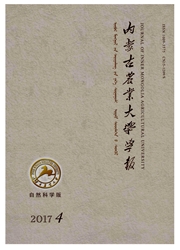

 中文摘要:
中文摘要:
采用埋袋法对毛乌素沙地天然臭柏、油蒿群落的分解速率在2005年4~10月,2006年4~10月间进行了为期2年的动态研究,并同步测定样地的温度、相对湿度、露点温度、绝对湿度、土壤含水率等影响因子。建立了细根重量保持率与时间的数学关系式,揭示了群落内部气象因子的动态变化。结果表明:臭柏和油蒿细根分解系数相差较大(P〈0.05),细根分解系数在臭柏群落与臭柏灌丛间差异不显著,臭柏分解系数为油蒿分解系数的44.44%。在对细根分解与其影响因子的相关分析基础上,探讨沙区生态系统中气象因子、土壤水分对细根分解速率的影响,这部分工作的开展对于揭示沙区生态系统的物质循环和能量流动具有重要理论意义。
 英文摘要:
英文摘要:
The dynamic study on the fine roots'decomposition rates of Sabina vulgaris and Artemisia ordosiea communities was made by the means of a two - year buried bag experiment in MU US Sandland. At the same time, the micro -climate factors and soil moistures were measured. The mathematical models of fine roots mass remaining rate with decomposition duration were set up, and the changes of climate factors were analyzed. The results showed as follows : the significant difference of an annual decomposition coefficient between S. vulgaris and A. ordosiea was found ( p 〈 0.05 ) , while the annual decomposition coefficient of S. vulgaris between communities and clusters was not detected significantly. The annual decomposition coefficient of S. vulgaris accounted for 30. 74% of A. ordosiea. Moreover, on the basis of correlation analysis to fine roots decomposition and influence factors, the micro - climate factors and soil moistures of sandland ecosystems effected on decomposition speed of fine roots was discussed, it is useful to further understand substance recycle and energy return of sandland ecosystems.
 同期刊论文项目
同期刊论文项目
 同项目期刊论文
同项目期刊论文
 期刊信息
期刊信息
